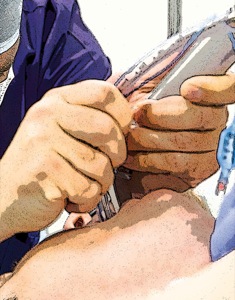=====
明けましておめでとうございます!
遅くなりましたが、おかげさまで元気にこちらで年を越せました。
こちらは新年の雰囲気がなく、むしろ2月の旧正月の方が新年らしくなるのではないかと期待しています。
私の病院では週2〜3回、朝に朝食付きの勉強会/医局会のような集まりがあります。ほとんど全て心臓外科と合同で、休憩室やごはんを食べる場所も外科といっしょなので、外科のドクターとの距離感は非常に近いです。
先日、不定期で行われる抄読会に、いきなり「来週やってね!」と言われ抄読会も苦手なのに英語なんて‼絶対無理‼と真っ青になりました。が、笑いをさそうスライドでなんとかほがらかに終わりました(笑)。
テーマは'' Infectious complications after
cardiac surgery''
先月の術後感染率が増加していたため、外科・麻酔科合わせて熱い議論になりました。
ちなみに、この部屋にいるドクターだけでも国籍、人種は多岐に渡り、マレー系マレーシア人、中国系マレーシア人、インド系マレーシア人、日本人、ベトナム人、インドネシア人、ミャンマー人、インド人、イラン人、イラク人、イエメン人、スーダン人、エジプト人…。
これだけバックグラウンドの違う人たちと冗談を言いながら仲良くいっしょに働けるのは本当に幸せなことです。
貴重な経験をさせていただき、先生方には本当に感謝しております。
当直明けがお休みで、祝日と週末合わせて、これから2泊で日本に帰ります!お寿司がどうしても食べたくなりまして。。
冬服がまったくないので東京には寄れませんが、近いうちに先生方にお会いできるのを楽しみにしています。
雪で大変だと聞いていますが、お気をつけてお過ごし下さい。
ではまた!





 “There are currently no prospective, multicenter studies assessing residual paralysis in Canada,” said Andre Galarneau, PhD, medical advisor at Merck Canada in Kirkland, Quebec, who led the study. “When we started asking researchers to estimate the incidence of residual paralysis in their centers, everyone was saying between 10% and 15%. But as we found out, it’s actually a lot more than that.”
“There are currently no prospective, multicenter studies assessing residual paralysis in Canada,” said Andre Galarneau, PhD, medical advisor at Merck Canada in Kirkland, Quebec, who led the study. “When we started asking researchers to estimate the incidence of residual paralysis in their centers, everyone was saying between 10% and 15%. But as we found out, it’s actually a lot more than that.”

